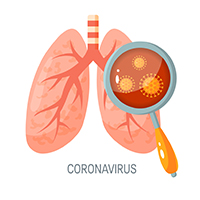Effectiveness and applicability of Non-Invasive Ventilation (NIV) in the Emergency Department in acute respiratory failure due to Sars-CoV-2 pneumonia

Accepted: 9 June 2020
All claims expressed in this article are solely those of the authors and do not necessarily represent those of their affiliated organizations, or those of the publisher, the editors and the reviewers. Any product that may be evaluated in this article or claim that may be made by its manufacturer is not guaranteed or endorsed by the publisher.
Treatment of de novo acute hypoxic respiratory failure is not recommended by current Non-Invasive Ventilation (NIV) guidelines as it does not seem to improve patients outcome. Many cases of acute hypoxic respiratory failure associated with Sars-Cov2 infection (SARI) have been observed during Sars-Cov2 pandemic. So far, data are missing regarding the use of NIV, but a correct identification of subgroups of patients based on different clinical, patho-physiological and radiological features, might be helpful for stratifying patients and choosing the correct respiratory support (invasive versus non-invasive). In case of NIV appliance, risk of environmental virus dispersion is particularly elevated; therefore, extreme attention by operators is required.
BTS guidelines Non-invasive ventilation in acute respiratory failure. Thorax 2002; 57: 192–211 DOI: https://doi.org/10.1136/thorax.57.3.192
Davidson AC, Banham S, Elliott M, et al. BTS/ICS guideline for the ventilatory management of acute hypercapnic respiratory failure in adults. Thorax 2016; 71: ii1–ii35. DOI: https://doi.org/10.1136/thoraxjnl-2015-208209
Rochwerg B, Brochard L, Elliott M, et al. Official ERS/ATS clinical practice guidelines: non invasive ventilation for acute respiratory failure. European Respiratory Journal 2017; 50: 1-20 DOI: https://doi.org/10.1183/13993003.02426-2016
Keenan SP, Sinuff T, Burns KEA, et al. Clinical practice guidelines for the use of noninvasive positive-pressure ventilation and non invasive continuous positive airway pressure in the acute care setting. CMAJ 2011 183 (3) E195-E214. DOI: https://doi.org/10.1503/cmaj.100071
Navalesi P, Campanini M, Lari F et al. La ventilazione non invasiva in medicina interna. Monografia, Quaderni dell’Italian Journal of Medicine, https://doi.org/10.4081/itjm.q.2015.5 DOI: https://doi.org/10.4081/itjm.q.2015.5
Lari F, Giostra F, Bragagni G, et al. Noninvasive ventilation for acute respiratory failure: state of the art (Part I). Italian Journal of Medicine 2009; 3 (4): 201-211. https://doi.org/10.4081/itjm.2009.201 DOI: https://doi.org/10.4081/itjm.2009.201
Lari F, Giostra F, Bragagni G, et al. Noninvasive ventilation for acute respiratory failure: state of the art (Part II). Italian Journal of Medicine 2010; 4 (1): 6-15. https://doi.org/10.4081/itjm.2010.6 DOI: https://doi.org/10.4081/itjm.2010.6
Confalonieri M, Salton F, Fabiano F. Acute Respiratory Distress Syndrome. Eur Resp Rev 2017; 26. https://doi.org/10.1183/16000617.0116-2016 DOI: https://doi.org/10.1183/16000617.0116-2016
Acute Respiratory Distress Syndrome: The Berlin Definition, The ARDS Definition Task Force. JAMA. 2012; 307 (23): 2526-2533. DOI: https://doi.org/10.1001/jama.2012.5669
Alhazzani W, Hylander Møller M, Arabi YM. Surviving Sepsis Campaign: Guidelines on the Management of Critically Ill Adults with Coronavirus Disease 2019 (COVID-19). Intensive Care Med 2020. https://doi.org/10.1007/s00134-020-06022-5. DOI: https://doi.org/10.1007/s00134-020-06022-5
Tobin MJ. Basing Respiratory Management of Coronavirus on Physiological Principles. Am J Respir Crit Care Med. 2020 Apr 13. doi: https://doi.org/10.1164/rccm.202004-1076ED. DOI: https://doi.org/10.1164/rccm.202004-1076ED
Colombi D, Bodini FC, Petrini M et al. Well-aeratedLung on AdmittingChest CT to PredictAdverseOutcome in COVID-19 Pneumonia. Radiology 2020 in press. https://doi.org/10.1148/radiol.2020201433. DOI: https://doi.org/10.1148/radiol.2020201433
Tonelli R, Fantini R. Tabbì L et al. Inspiratory Effort Assessment by Esophageal Manometry Early Predicts Noninvasive Ventilation Outcome in de novo Respiratory Failure: A Pilot Study. American Journal of Respiratory and Critical Care Medicine 2020 in press. DOI: https://doi.org/10.1164/rccm.201912-2512OC
Gattinoni L, Chiumello D, Rossi S. COVID-19 pneumonia: ARDS or not? Critical Care (2020) 24:154 https://doi.org/10.1186/s13054-020-02880-z DOI: https://doi.org/10.1186/s13054-020-02880-z
Gattinoni L. Chiumiello D, Caironi P et al. COVID 19 pneumonia: different respiratory reatments for different phenotypes? Intensive Care Med 2020. https://doi.org/10.1007/s00134-020-06033-2 DOI: https://doi.org/10.1007/s00134-020-06033-2
Marini J, Gattinoni L. Management of COVID-19 respiratory distress. JAMA Insights, Published online April 24, 2020. DOI: https://doi.org/10.1001/jama.2020.6825
Clinical management of severe acute respiratory infection (SARI) when COVID-19 disease is suspected. WHO 13.3.2020
Gestione pneumologica dei pazienti con infezione respiratoria da COVID-19. ITS/AIPO 8.3.2020 http://www.aiponet.it/news/speciale-covid-19/2419-covid-19-gestione-pneumologica-dei-pazienti-con-infezione-respiratoria-da-coronavirus.html
Roca O et al. An Index Combining Respiratory Rate and Oxygenation to Predict Outcome of Nasal High-Flow Therapy. American Journal of Respiratory and Critical Care Medicine 2019 Jun 1;199(11):1368-1376. doi: https://doi.org/10.1164/rccm.201803-0589OC. DOI: https://doi.org/10.1164/rccm.201803-0589OC
Papazian L, Aubron C, Brochard L et al. Management of acute respiratory distress syndrome. Annals of Intensive Care 2019, 9 (69). https://doi.org/10.1186/s13613-019-0540-9 DOI: https://doi.org/10.1186/s13613-019-0540-9
PAGEPress has chosen to apply the Creative Commons Attribution NonCommercial 4.0 International License (CC BY-NC 4.0) to all manuscripts to be published.


 https://doi.org/10.4081/ecj.2020.9127
https://doi.org/10.4081/ecj.2020.9127







